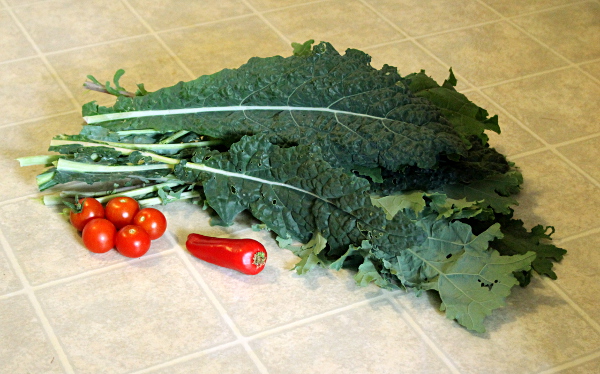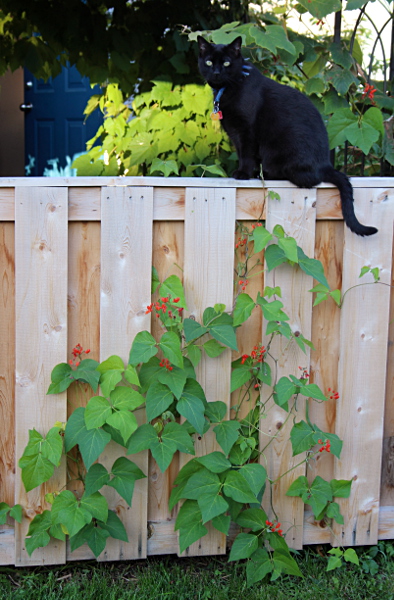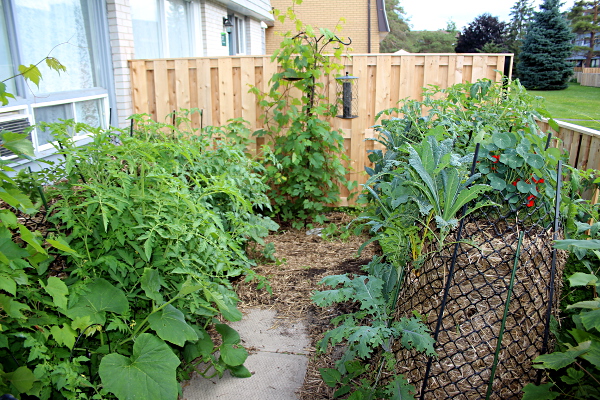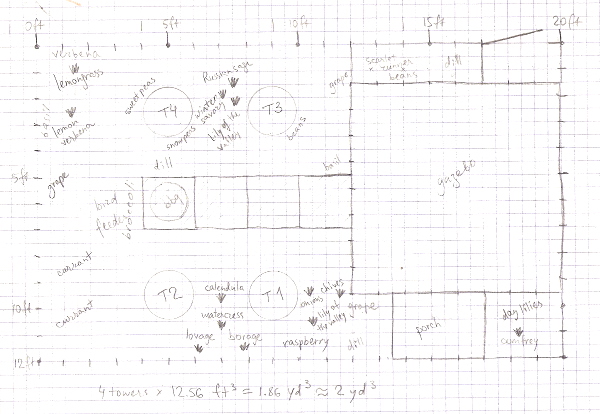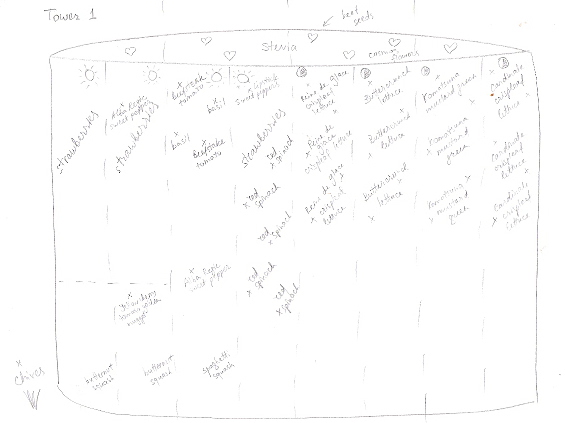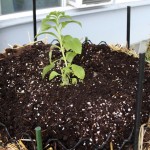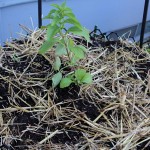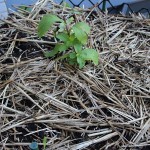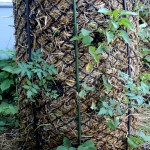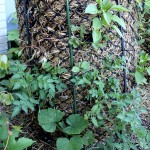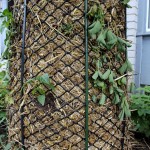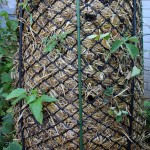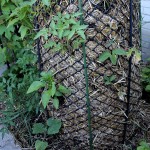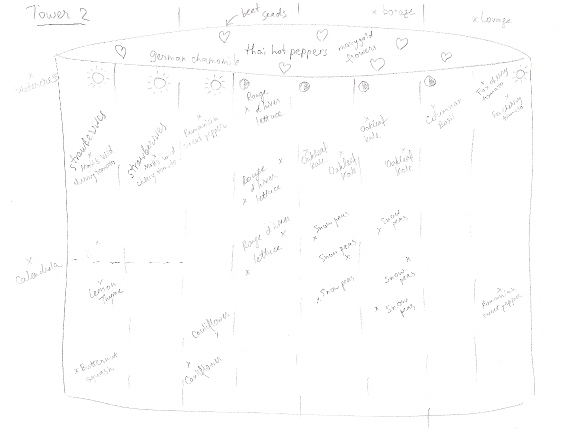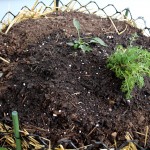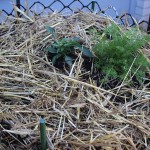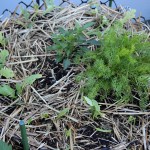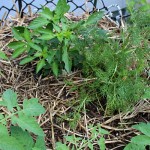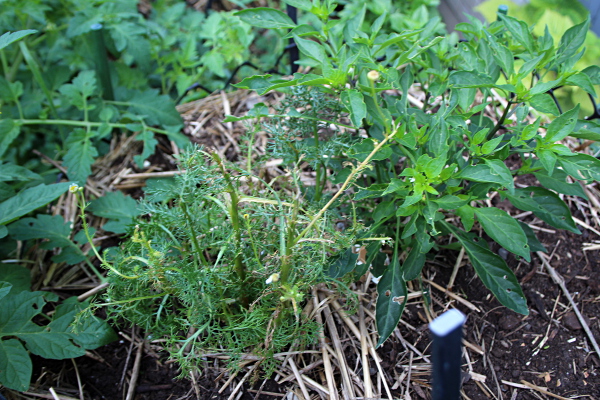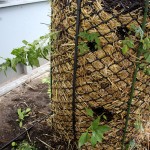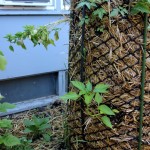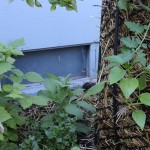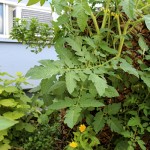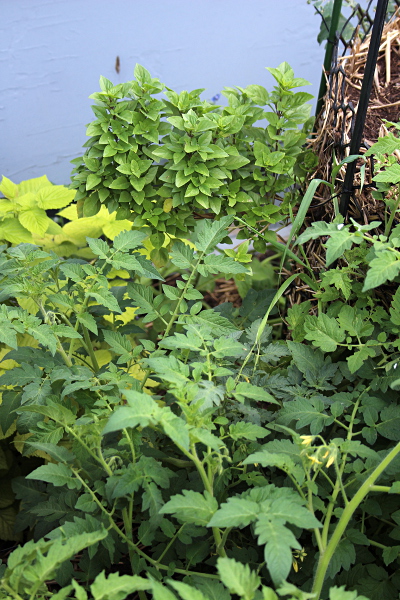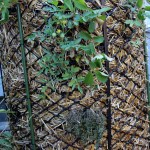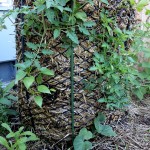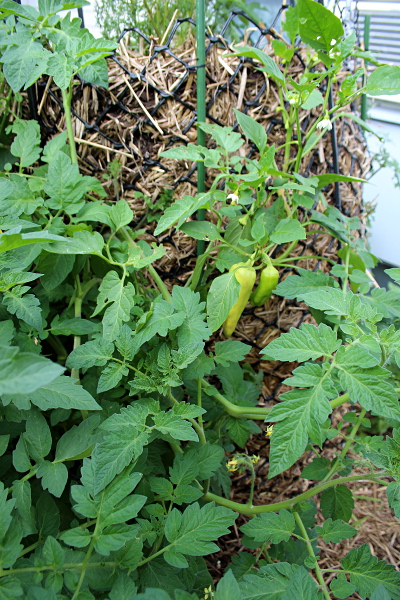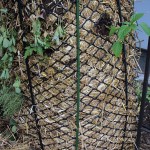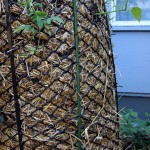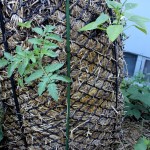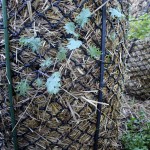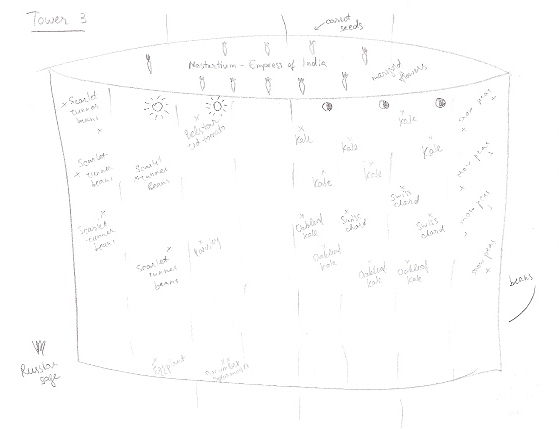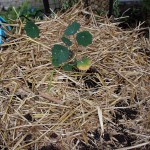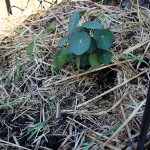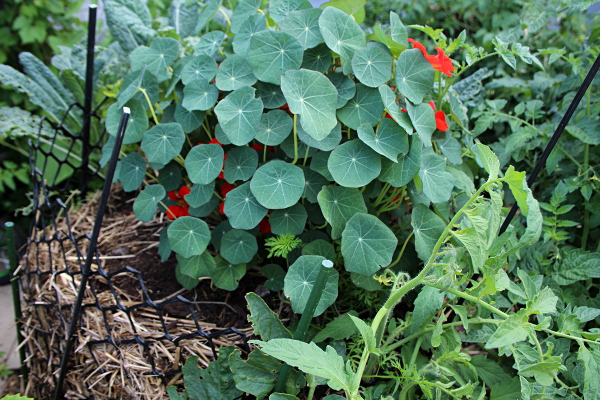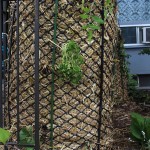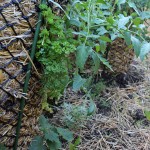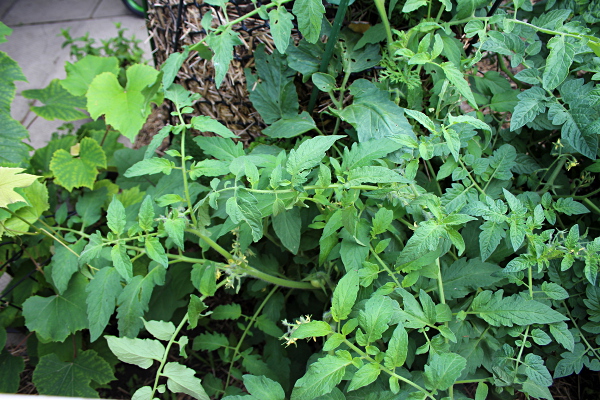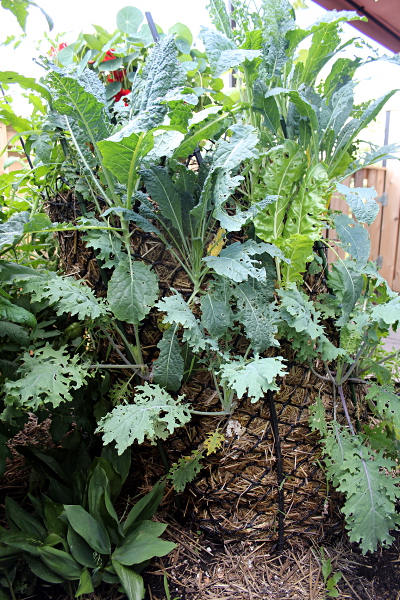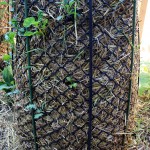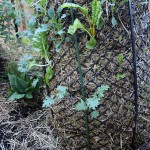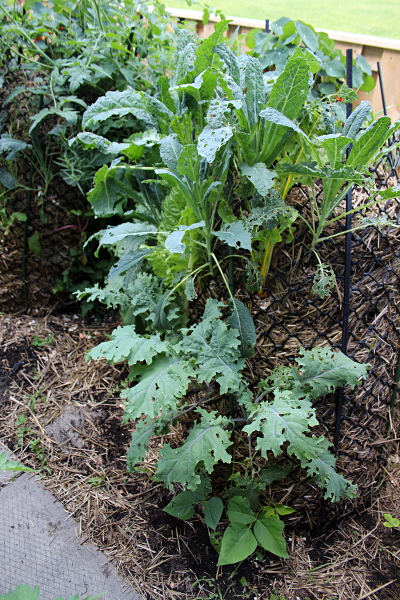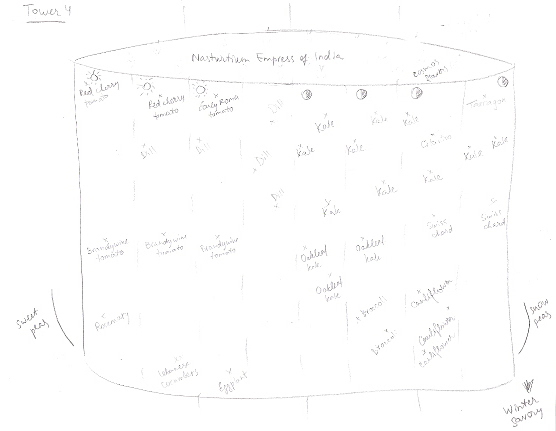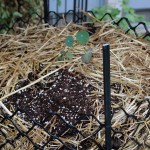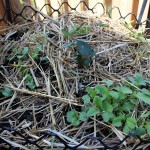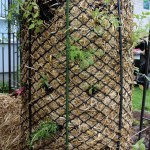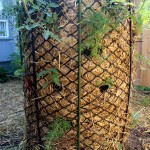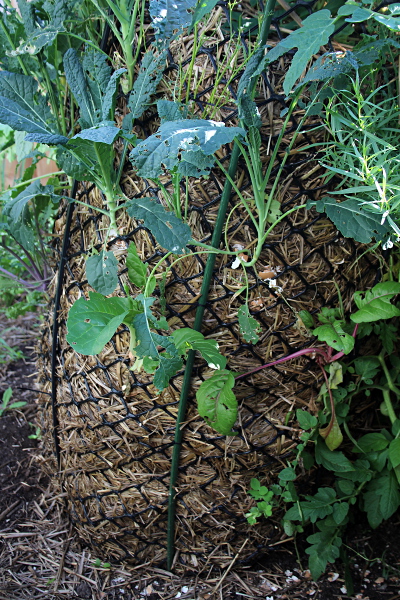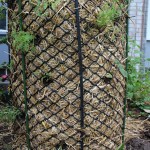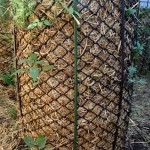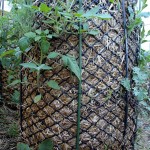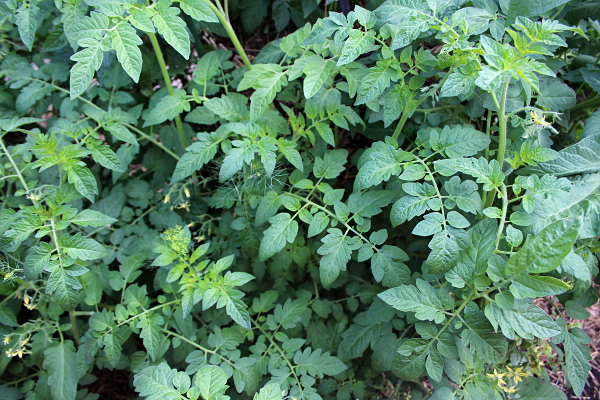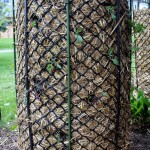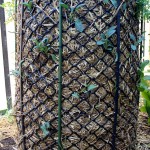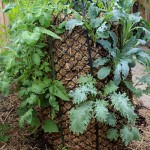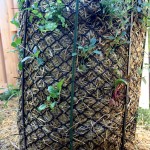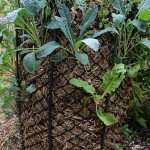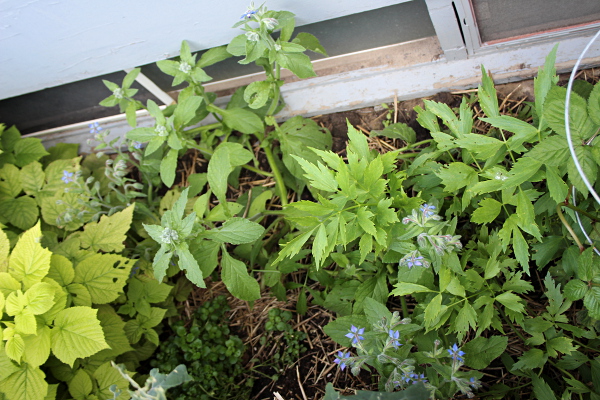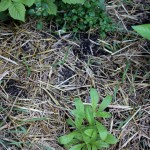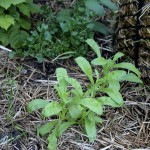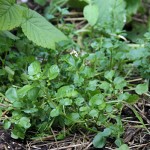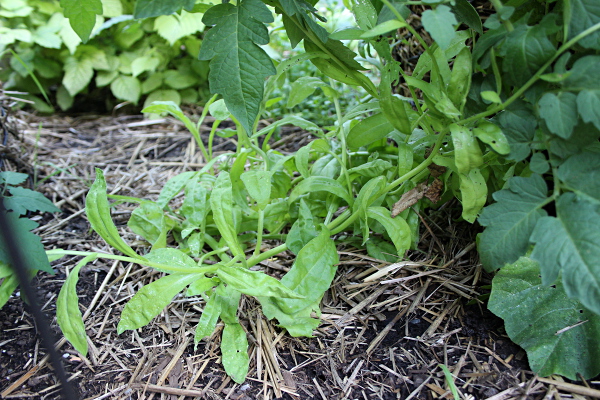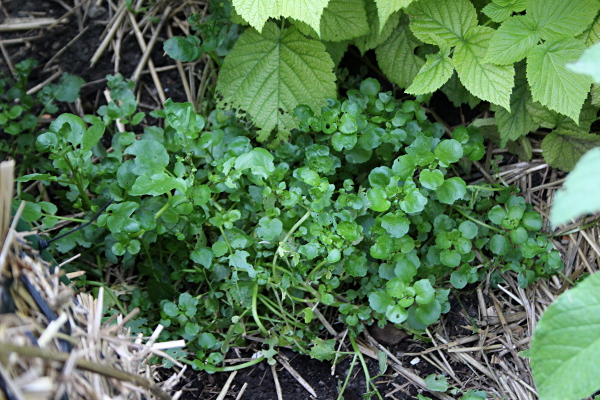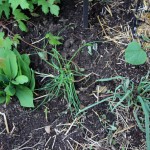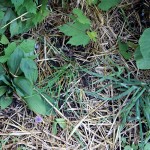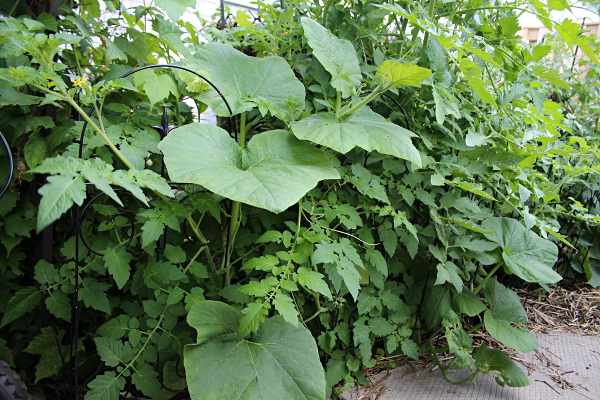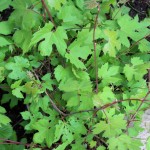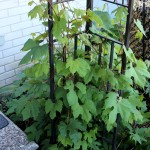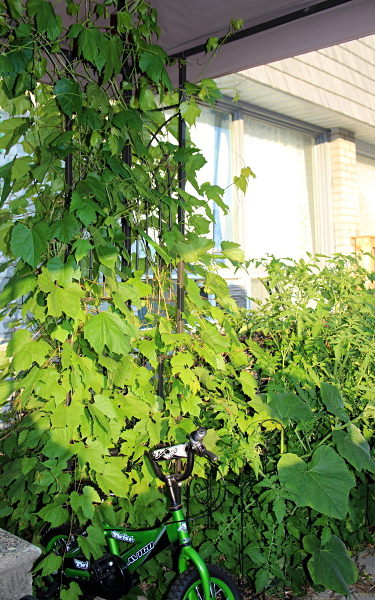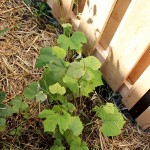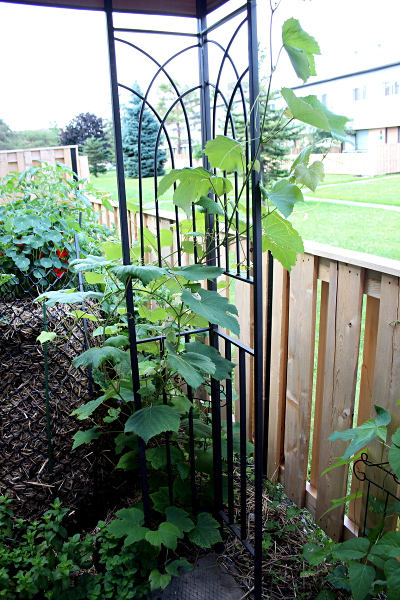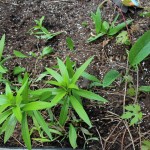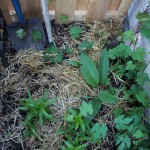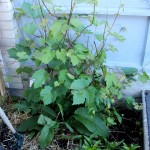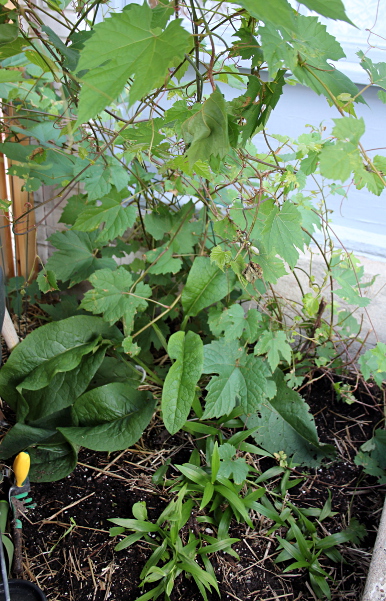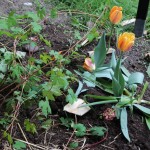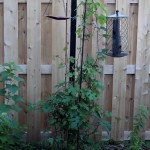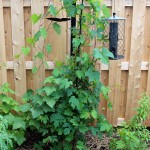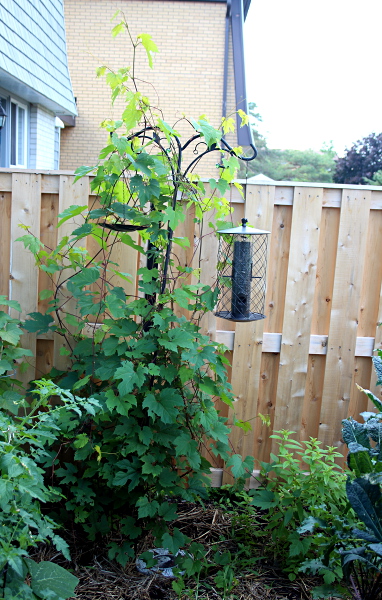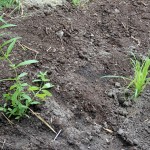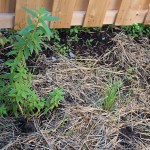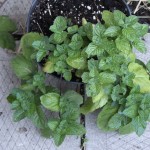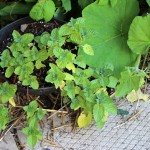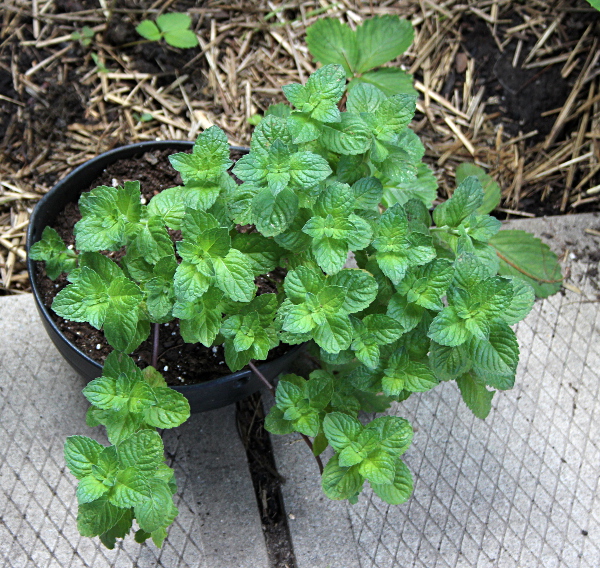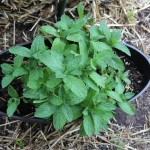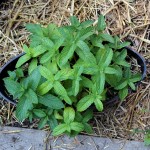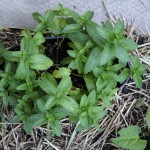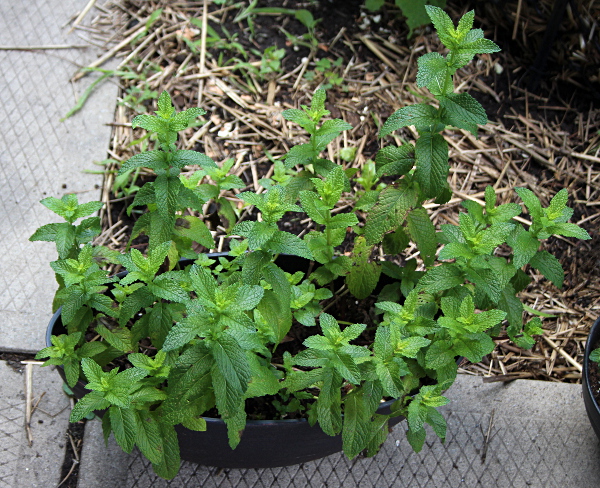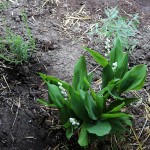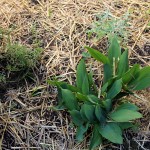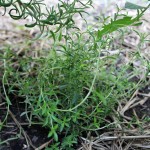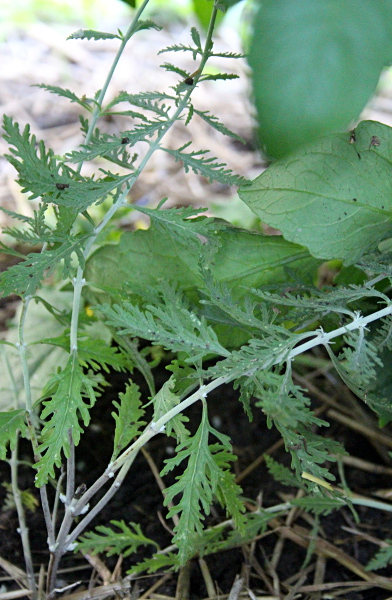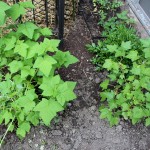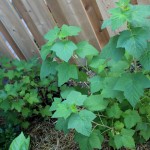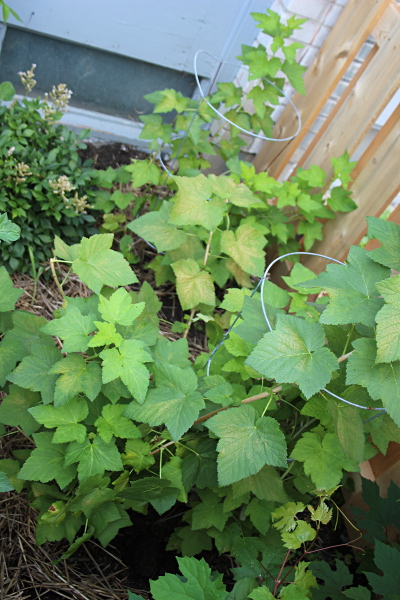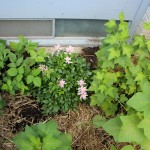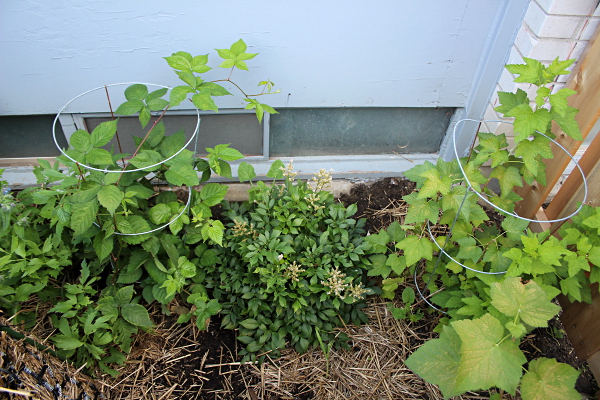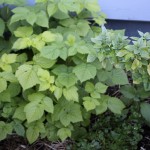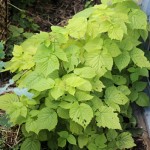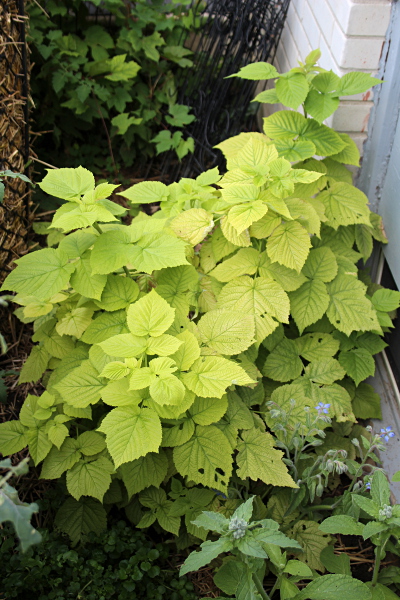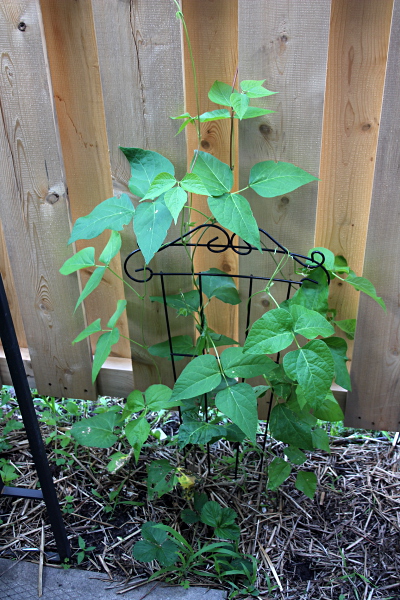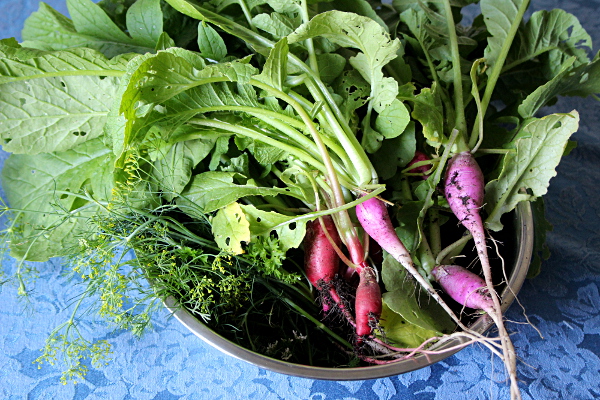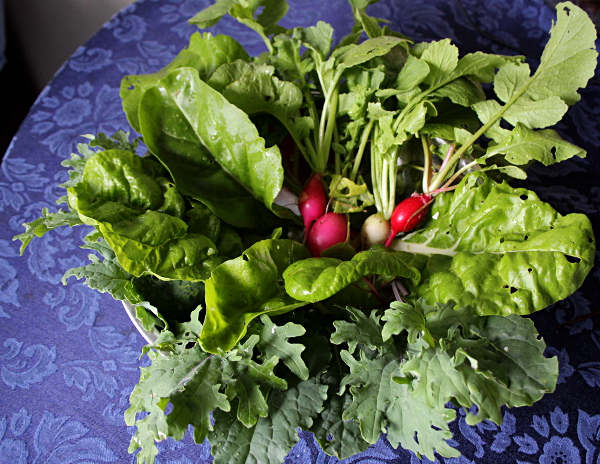Following the garden preparations and the building of permaculture towers, I have planted different types of large and cherry tomatoes, eggplants, sweet and hot peppers, carrots and radishes, butternut and spaghetti squash, kale and Swiss chard, cucumbers, and a variety of herbs. Below are the photos and notes on each plant’s uses, environmental preferences, and useful plant combinations. Please note that “shady side” in my garden implies only partial shade, as we get lots of sunlight and heat during the summer.
The full plan of the garden includes 4 plant towers (T1 to T4), four-stone path where we have the barbeque set, a few bushes, herbs, and flowers planted in between the towers, and the gazebo to cover a paved patch of the garden.
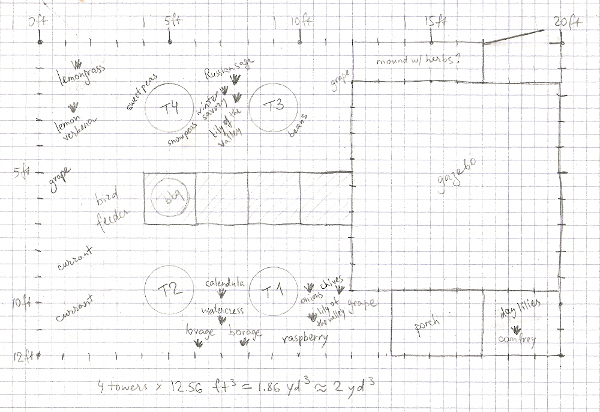
Since my planting completed just as our fence replacement was supposed to start, the gazebo has been shifted over the towers while the construction has been done, so the photos reflect that.
Tower 1

Stevia
Planted 1 on top of Tower 1. Loves full sun. Naturally sweet plant, the leaves can be used to sweeten drinks and salads. The sweetness comes from two chemicals: Rebaudioside A and stevioside.
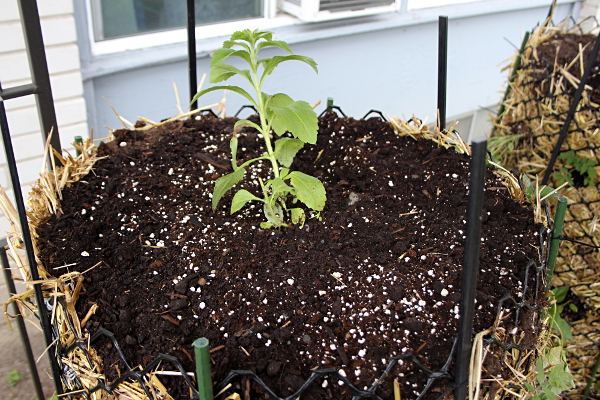
Stevia on top of Tower 1
Purple Basil
Planted 2 in Tower 1, under tomatoes, looking droopy upon transplanting – I don’t think it shall survive. Basil has always been tricky in my garden.
Alba Regie Sweet Peppers
Planted 2 in Tower 1 – one in top third among strawberries, next to beefsteak tomatoes, another in bottom half above spaghetti squash, both on sunny side.
Endangered Hungarian heirloom.
Lipstick Sweet Peppers
Planted in Tower 1, above strawberries, top row, sunny side.
Early, heavy yields.
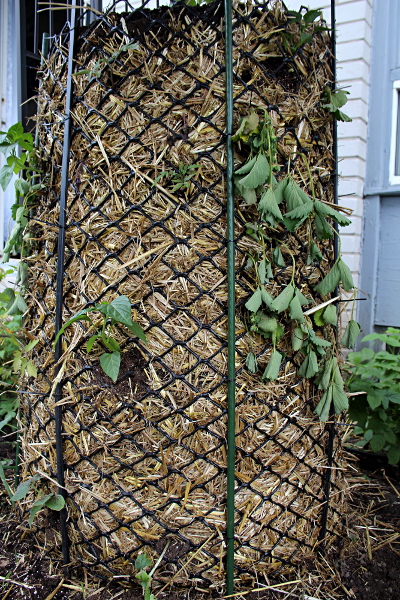
Beefsteak tomatoes, half-dead purple basil, Alba Regie pepper and spaghetti squash in one section, Lipstick sweet pepper and strawberries in the next
Strawberries
Once we had removed the stone tiles that covered the part of our yard that is now a garden, three years ago, strawberries have sprung up. Since then they have taken over a large part of the garden and I had to remove them to make space for the towers. In the process, I have transplanted some to Tower 1, sunny side, top half. Most of them did not survive the transplant shock, but a few plants are still fighting.
Beefsteak Tomatoes
Planted 2 in Tower 1 in rows 1 and 2, on the sunny side, next to basil, between sweet Alba Regie and Lipstick sweet peppers.
Flavourful tomatoes, got seedlings from a friend.
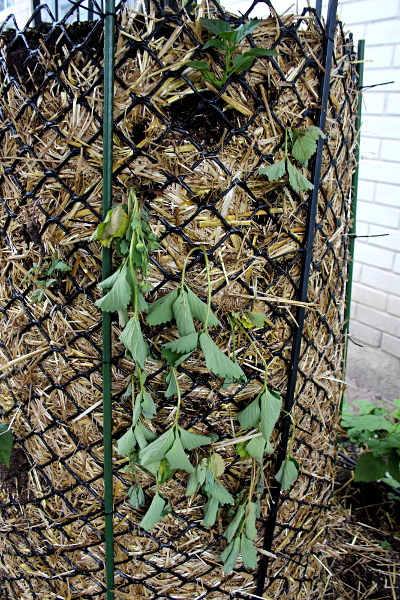
Closeup of Lipstick sweet pepper and strawberries
Butternut Squash
Planted 2 in Tower 1, bottom row, next to spaghetti squash, sunny side.
Spaghetti Squash
Planted 1 in Tower 1, bottom row, next to butternut squash, sunny side.
Yellow Cherry, Gold Nugget Tomatoes
Planted 1 in Tower 1, lower third, sunny side, above butternut squash, under the strawberries.
Early cherry tomato.
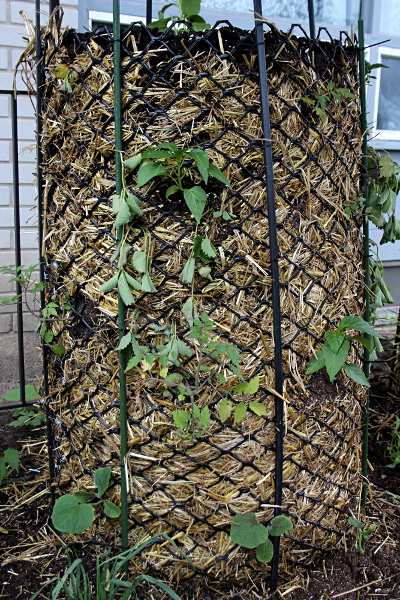
Yellow cherry Gold Nugget tomato and butternut squash in one section, and in another -Alba Regie sweet pepper among strawberries, another Yellow cherry Gold Nugget tomato and another butternut squash.
Tower 2
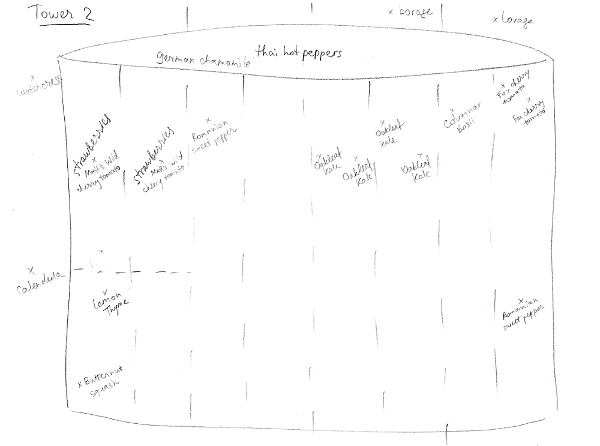 German Chamomile
German Chamomile
Planted 1 on top of Tower 2, next to a red bell pepper.
“It has been said that if you have a failing plant, simply plant chamomile next to it and it will revive.”
Likes full sun
Hot Thai Peppers
Planted on top of Tower 2, next to German chamomile.
Chili plants love heat and full sun, and there are several ways to preserve peppers.
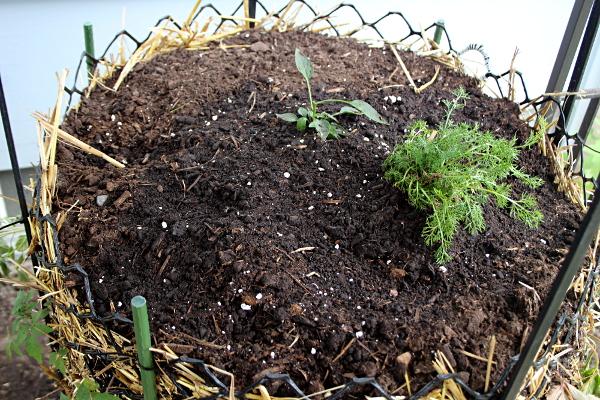
Thai hot pepper and German chamomile plants on top of Tower 2
Columnar Basil
Planted 1 in Tower 2, within the top third.
Planting basil with tomatoes protects them by repelling insects. Basil prefers partial sun.
Fox Cherry Tomatoes
Planted 2 in Tower 2, top row, sunny side, between columnar basil and Matt’s wild cherry tomatoes.
Loves full sun, very prolific.
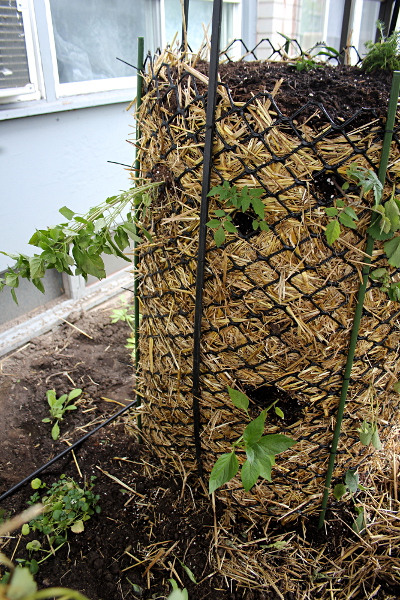
Columnar basil in one section, two Fox cherry tomatoes and a Romanian sweet pepper in the next
Strawberries
Transplanted some to Tower 2, sunny side, top half. Most of them did not survive the transplant shock, but a few plants are still fighting. Strawberries produce more in full sun.
Matt’s Red Tomatoes
Planted 2 in Tower 2, next to strawberries, in the top half, on the sunny side.
Deep red cherry tomato.
Lemon Thyme
Planted in Tower 2, sunny side, in the bottom half above the butternut squash, under the Matt’s Wild cherry tomato.
Good to use in marinades that call for lemon, likes full sun to part shade.
Butternut Squash
Planted 1 in Tower 2, bottom row, under lemon thyme, sunny side.
Butternut squash prefers direct sunlight.
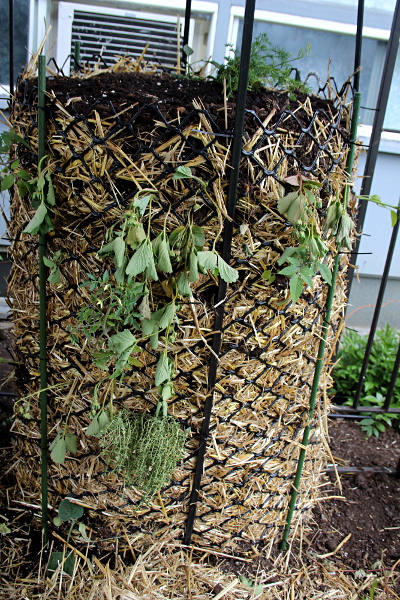
Droopy strawberries, Matt’s Wild tomato in their midst, and lemon thyme underneath, with a butternut squash at the bottom in one section, and more strawberries and another Matt’s Wild tomato in the next section
Romanian Sweet Pepper
Planted 2 in Tower 2, one in top third, next to strawberries and Matt’s wild cherry tomatoes, another one in bottom third, under fox cherry tomatoes, both on sunny side.
Romanian heirloom, very sweet.

Closeup of strawberries and another Matt’s Wild tomato in the second section from the photo before, and a single Romanian sweet pepper in the next section
Oakleaf Kale
Planted 4 in Tower 2, in the top third, on the shady side.
Prefers full sun or partial shade. Unsure if that’s the Red Ursa or Russian Kale, will have to find out once it grows.
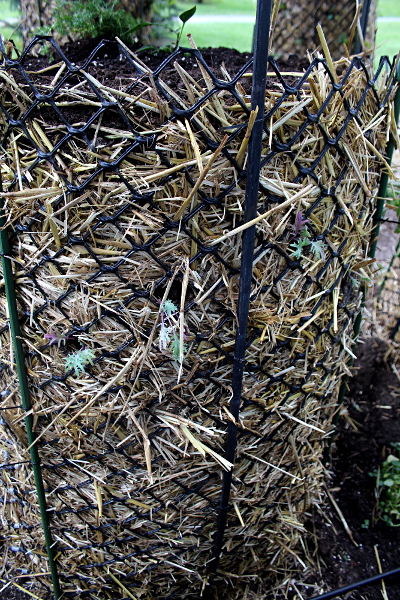
Two oakleaf kale seedlings in one section, and two more in the next one
Tower 3
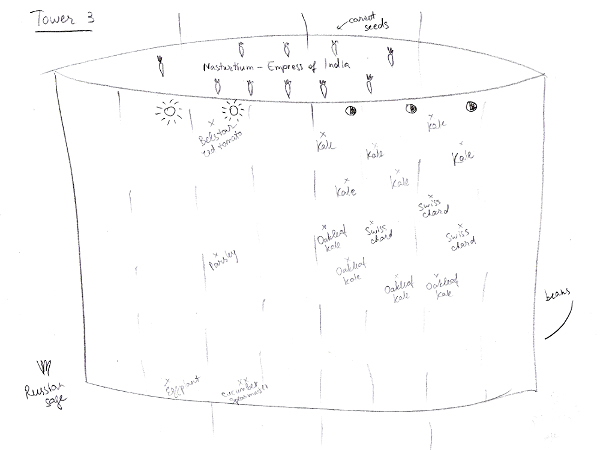 Nasturtium (Empress of India)
Nasturtium (Empress of India)
Planted 1 on top of Tower 3, surrounded by carrot seeds.
Loved by predatory insects and bees, edible flowers. Likes full sun.
Carrots (seed)
Planted on top of Tower 3, surrounding the nasturtium plant.
Will need to try mixing with radish seeds, perhaps the next batch.
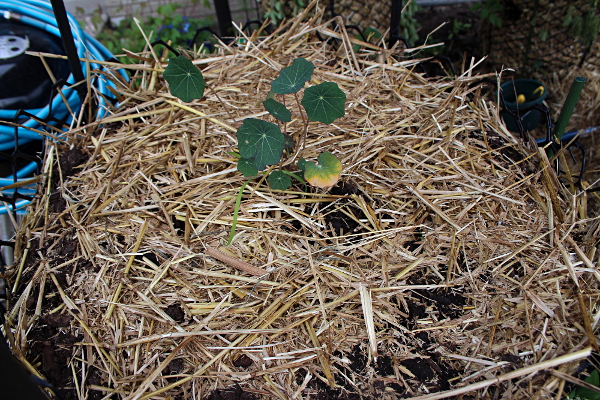
Nasturtirum – Empress of India – on top of Tower 3, surrounded by carrot seeds
Japanese Pickling Eggplant
Planted 1 Tower 3, lower level, sunny side, next to cucumbers.
Likes full sun.
Bellstar Red Tomatoes
Planted 1 in Tower 3, top row, sunny side, above parsley.
Early plum tomato, likes full sun.
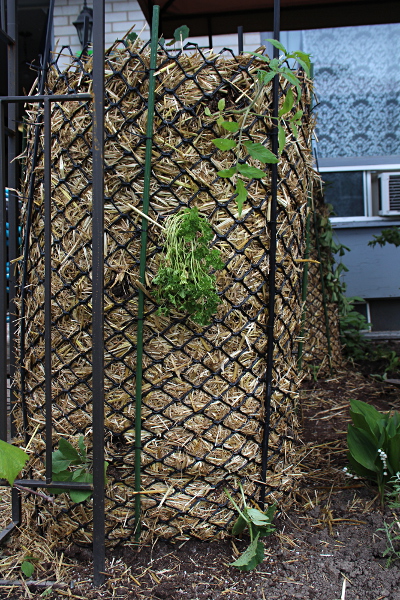
Japanese eggplant at the bottom of one section, and in the next one – Bellstar red tomato, parsley, and at the bottom Spacemaster cucumber.
Spacemaster Cucumber
Planted in Tower 3, bottom row, on a sunny side, under the parsley. Two plants did not want to separate root systems, so I planted both together.
Likes full sun, compact and good for pickling when smaller.
Curled Parsley
Planted in Tower 3, mid-way down, on a sunny side, under the Bellstar red tomato.
Likes full sun.
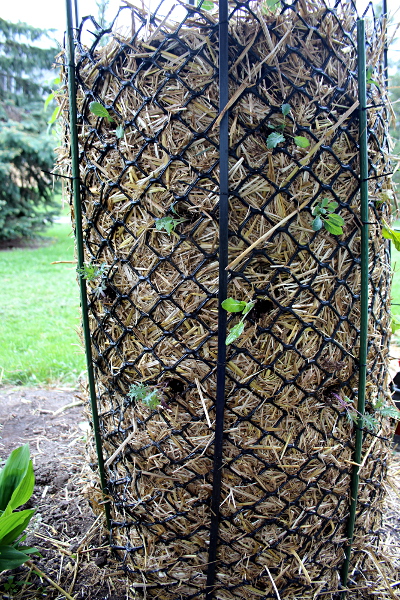
Two green kale and two oakleaf kale seedlings in one section, two green kale, one Swiss chard, and one oakleaf kale seedling in the next one.
Green Kale
Planted 6 in Tower 3, top half, shady side.
Likes full sun.
Oakleaf Kale
Planted 4 in Tower 3, next to green kale and Swiss chard, second half, shady side.
Prefers full sun or partial shade. See Tower 2 for more.

Another shot of two green kale, one Swiss chard and one oakleaf kale plant from the previous photo, and two more green kale, two Swiss chard, and one oakleaf kale seedling in the next section.
Swiss Chard
Planted 3 in Tower 3, on the shady side, middle rows, next to green kale and oakleaf kale.
Loves to be planted next to green beans, cabbage, broccoli, tomatoes.
Scarlet Runner Beans (seed)
Planted around Tower 3 base, on semi-shady side.
Attracts butterflies, hummingbirds and Russian women interested in permaculture.
Tower 4
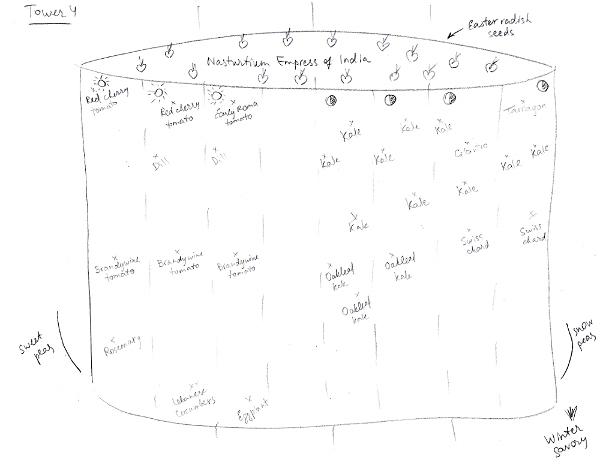
Nasturtium (Empress of India)
Planted 1 on top of Tower 4, surrounded by radish seeds.
Loved by predatory insects and bees, edible flowers. Likes full sun.
Easter Egg Radishes (seed)
Planted on top of Tower 4, surrounding the nasturtium plant.
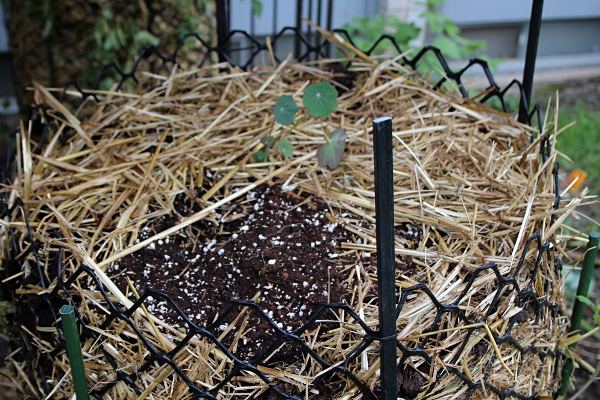
Nasturtium – Empress of India, surrounded by radish seeds.
Barbeque Rosemary
Planted in Tower 4, sunny side, below Brandywine tomatoes, lower third.
Prefers full sun, attracts bees and hummingbirds.
Brandywine Tomatoes
Planted 3 in Tower 4, middle row, sunny side, under dill and above rosemary.
In need of lots of sun and pruning.
Early Roma Tomatoes
Planted 1 in Tower 4, top row, sunny side, above dill, next to red cherry tomatoes.
Disease-resitant, need at least weekly watering.
Red Cherry Tomatoes
Planted 2 in Tower 4, top row, on the sunny side, next to dill.
Pinch out side shoots regularly.
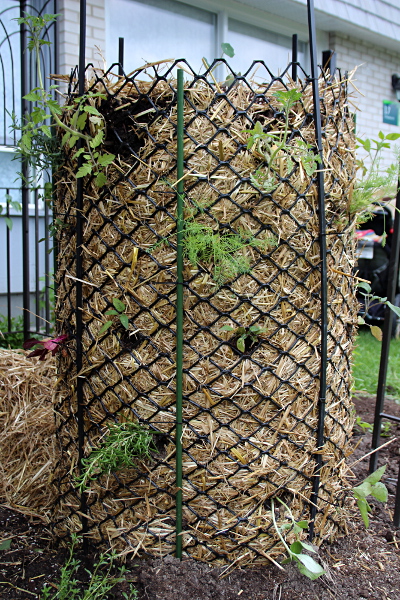
Red cherry tomato, Brandywine tomato, and rosemary below in one section, and in the next section – another red cherry tomato, followed by dill, a Brandywine tomato, and Lebanese cucumbers.
Dill
Planted 2 in Tower 4, under tomatoes, in the top third, on the sunny side.
Loves full sun. Plant next to cabbage or onions, but keep away from carrots.
Lebanese Cucumber
Planted 2 in Tower 4, lowest level, two together since the root systems were attached.
Prefer shade in hot climates
Try to keep the roots cool by applying mulch, to avoid cucumber beetles that can destroy the plants.
Japanese Pickling Eggplant
Planted 1 Tower 4, lower level, sunny side, next to cucumbers. See more in Tower 3.
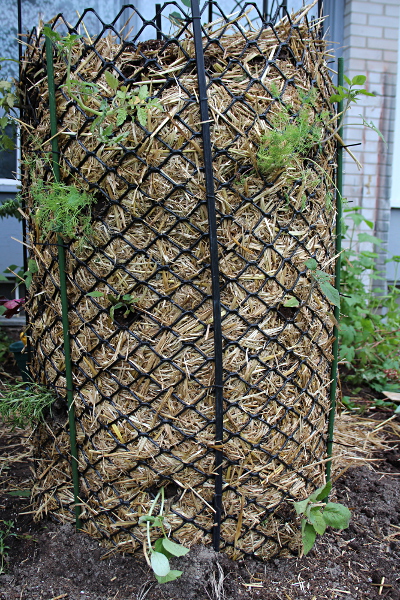
Red cherry tomato, followed by dill, a Brandywine tomato, and Lebanese cucumbers from the photo above, and in the next section – early Roma tomato, dill, Brandywine tomato, and eggplant at the bottom.
Green Kale
Planted 10 in Tower 4, top half, shady side. See more in Tower 3.
Oakleaf Kale
Planted 3 in Tower 4, next to green kale and Swiss chard, second half, shady side.
Prefers full sun or partial shade. See more in Towers 2 and 3.

Three green kale and two oakleaf kale in one section, and in the next – three green kale and one oakleaf kale
Cilantro
Planted 1 on the shady side in the top third of Tower 4.
Sensitive to heat, prefers full shade in hot climates.
Swiss Chard
Planted 2 in Tower 4, on the shady side, middle rows, next to green kale and oakleaf kale. See Tower 3 for more.
Tarragon
Planted 1 in Tower 4, top row, shady side, above green kale, next to red cherry tomatoes.
Full or part sun, likes moisture.
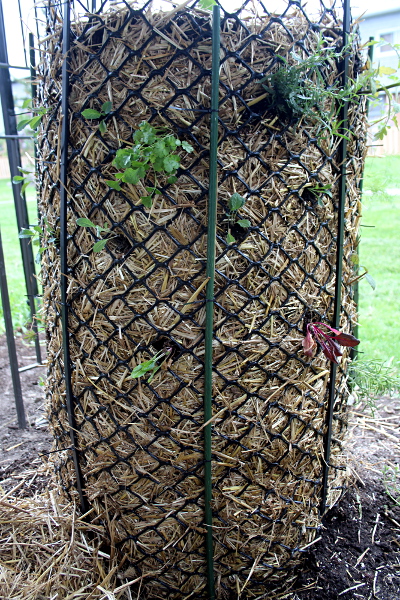
Cilantro between two green kale seedlings, and Swiss chard lower in one section, and in the next – tarragon, followed by two kale plants and a Swiss chard plant.
Sweet Peas (seed)
Around Tower 4 base, in the ground, on sunny side.
Prefer cool days, are great climbers.
Snow Peas (seed)
Around Tower 4 base, in the ground, on semi-shady side.
Prefer full sun to partial shade.
Plants in-between towers and around the garden:
Borage
Planted 1 in the ground, between Towers 1 and 2, close to the house.
Loved by bees, with edible purple flowers. It likes full or partial sun.
Lovage
Planted next to borage, between Tower 2 and the house, in the shade.
Likes full sun or partial shade
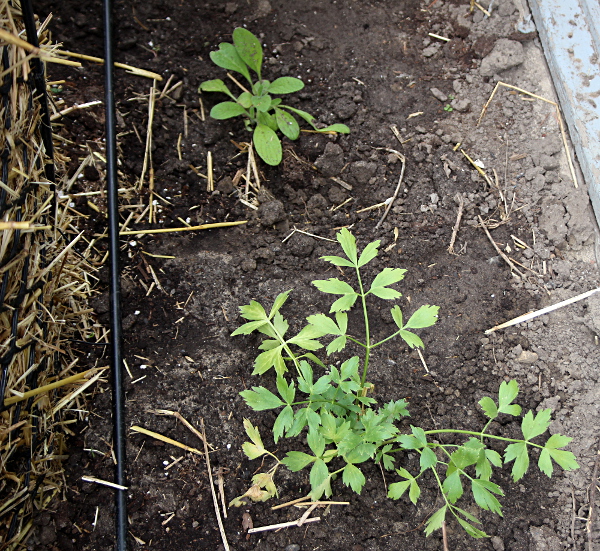
Borage at the top of photo, lovage lower, behind Towers 1 and 2
Calendula
Planted 1 in the ground, between Towers 1 and 2.
Full sun, tolerates moderate shade.
Attracts butterflies, bees and other beneficial insects.
Watercress
Planted between Towers 1 and 2, towards the house, in a small hollow I have formed, so that the water pools in it. A few days in, the plant is already flowering.
Full sun, tolerates light shade, grows best in semi-aquatic environments.

Calendula at the top of the photo, watercress lower
Chives
Planted 1 in the ground, next to Tower 1 and green onions.
Prefers sunny locations. Plant on the edge of the garden to repel insects.
Green onions
Next to chives and lily of the valley, there are some green onions that have sprouted from an old onion I had in the pantry. They seem to be thriving.
Lily of the Valley
Pulled out some to place Tower 3, and replanted it next to chives. Left the remainder between Tower 3 and Tower 4, it was still blooming.
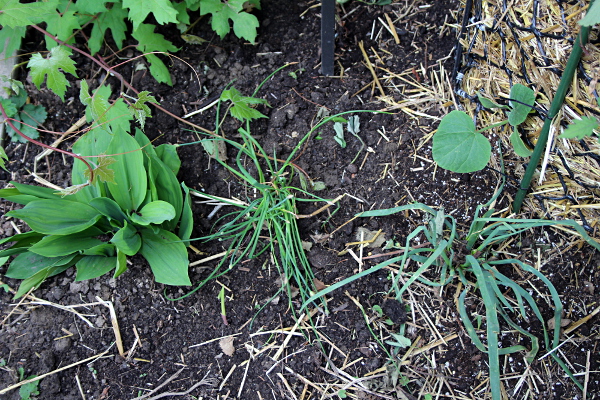
From left to right: grape vine 1, lily of the valley, chives, onions, Tower 1 butternut squash
Grapes
There are random vines coming up all throughout the garden. The largest vine is by the porch that I train to climb up the gazebo. Another smaller vine is on the other side of the porch, among the day lilies. It usually climbs up the other side of the gazebo and towards the window. Third vine climbs up the middle of the South fence. None of these vines produce berries.
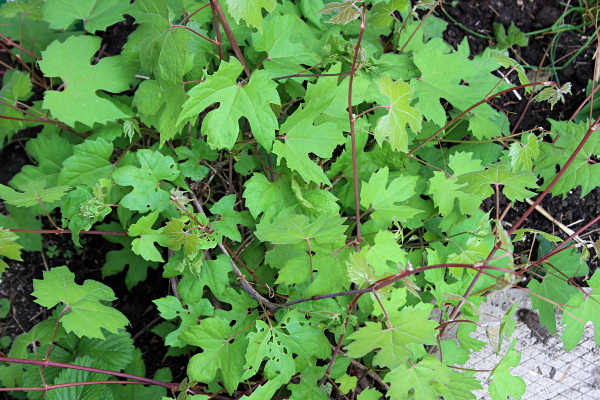
Grape vine 1, came with the property, does not give fruit
I have purchased and planted another vine last year – Concord Purple Grape, which is now next to Tower 3 and close to another gazebo support. Last year it did not produce berries. We shall see what happens this year.
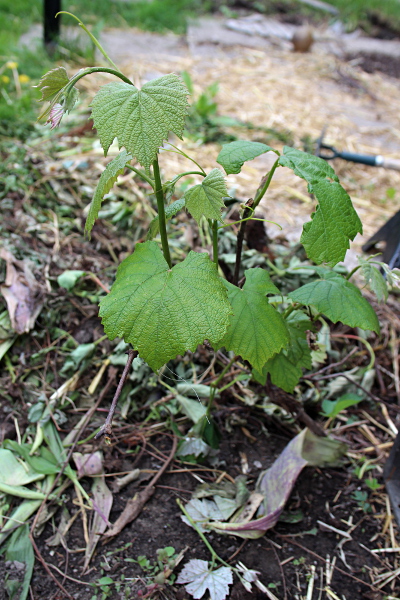
Grape vine 4, Concord Purple Grape, planted last year, next to Tower 3
Comfrey
Planted 1 separately from the Towers, next to the porch with the lilies.
Will grow in full or partial sun. Might take over the garden as it spreads like mint.
Day Lily
A few of them are coming up next to the porch, surrounding the comfrey plant. I usually replant the bulbs in the fall or leave the existing ones in the ground over the winter.
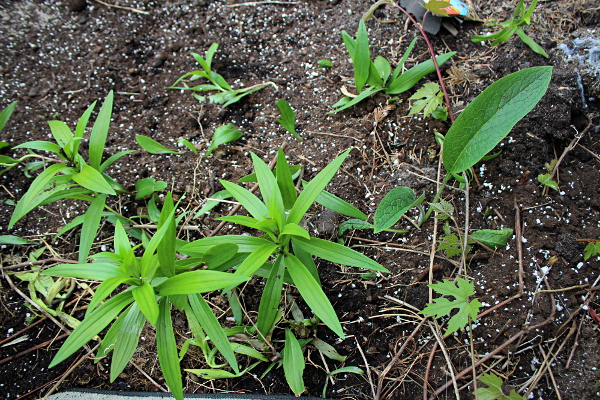
Day lilies, comfrey, and remains of grape vine 2, butchered during last year’s roof replacement
Hyacinths
Most have finished blooming and I have pulled out the bulbs to be planted in the fall.
Tulips
Done blooming, pulled out the remainder of the bulbs and saved them for the fall.
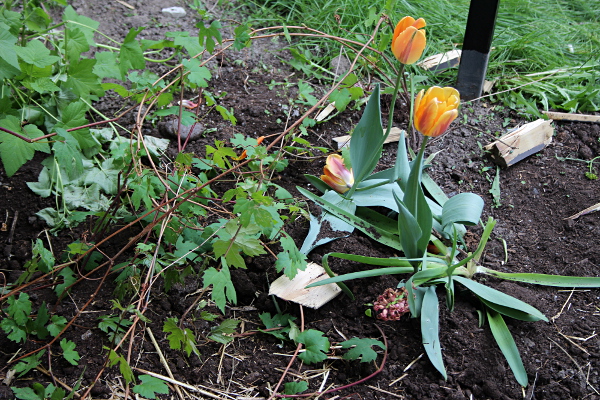
Grape vine 3, next to fence (to be reconstructed), with tulips and hyacinths
Lemongrass
Planted in the corner of the garden next to lemon verbena and Tower 4.
Full sun, natural insect repellent
The plant got somewhat trampled during fence replacement, but seems to still be alive.
Lemon Verbena
Planted along the South fence, next to lemongrass, close to Tower 4.
Full sun, natural insect repellent
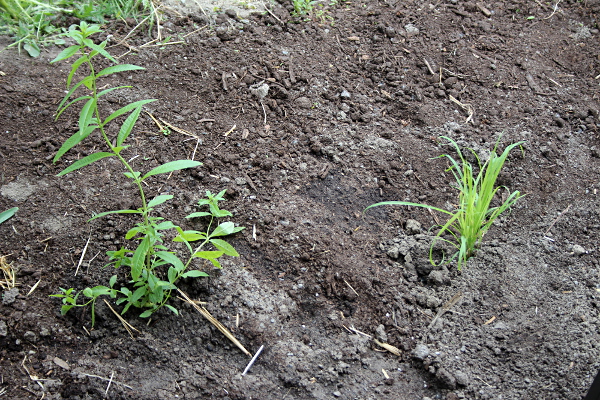
Lemon verbena on the left and lemongrass on the right
Grapefruit Mint
Planted in a pot, as mint frequently takes over the garden.
Likes full sun or partial shade

Grapefruit mint
Garden Mint
Planted in a pot, removed all the parts of the root system that has spread throughout the garden from the previous years.
Prefers cool moist areas but will grow in full sun.
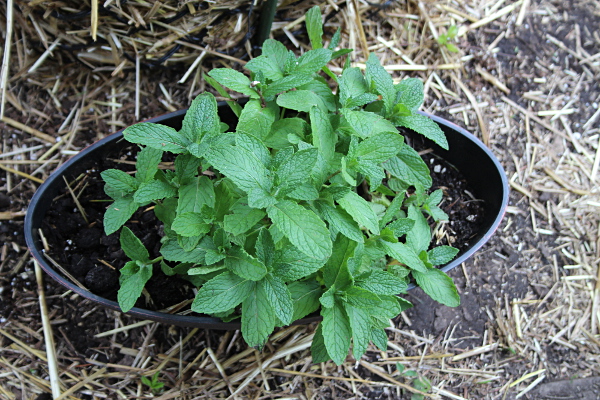
Garden mint
Russian Sage
Planted in the ground, between Towers 3 and 4, next to winter savory, partial shade. Drought-tolerant. Planting sage with onions, carrots, cabbage or turnips protects them by repelling insects.
Winter Savory
Planted in the ground, between Towers 3 and 4, next to Russian sage, partial shade.
Needs at least six hours of sun.
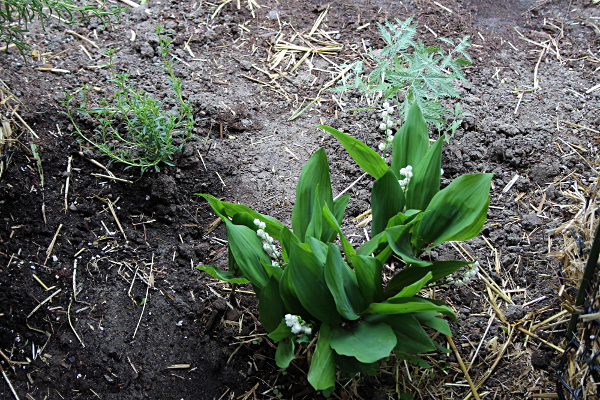
Left – winter savory, top right – Russian sage, bottom – lily of the valley
Black Currant
I have two bushes, both of which have been planted last year, yet I do not recall if both are black or one is red. They are planted next to each other along the South fence, next to Tower 2.
Permaculture favourite, since they can bloom in partial shade.
Blackberry
We have planted a blackberry bush last year, but it did not look like it was taking to our garden very well, and with the raspberries spreading like wildfire, I thought it was overrun. However, something is coming up along the window that does look like blackberry. We shall wait and see if it recovers.
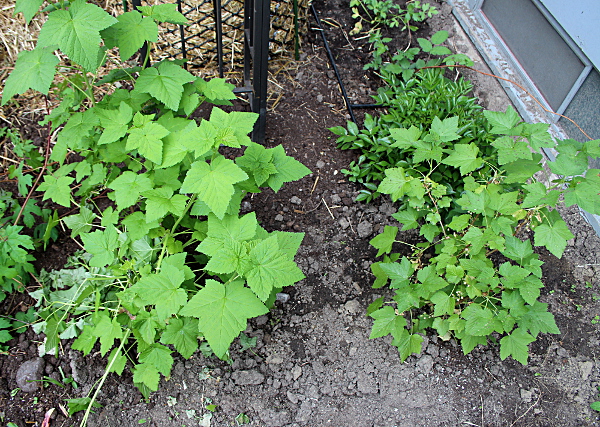
Two currant bushes between Tower 2 and the South fence, unknown perennial plant along the window, and what I suspect is our blackberry bush planted last year – Black Satin Blackberry.
Raspberry
We have planted Killarney Raspberry bush last year, and although it has not produced more than a handful of berries, it has spread through the garden quickly. I have removed some of it to pass on to a friend, leaving the initial bush. So far it is growing rapidly.






